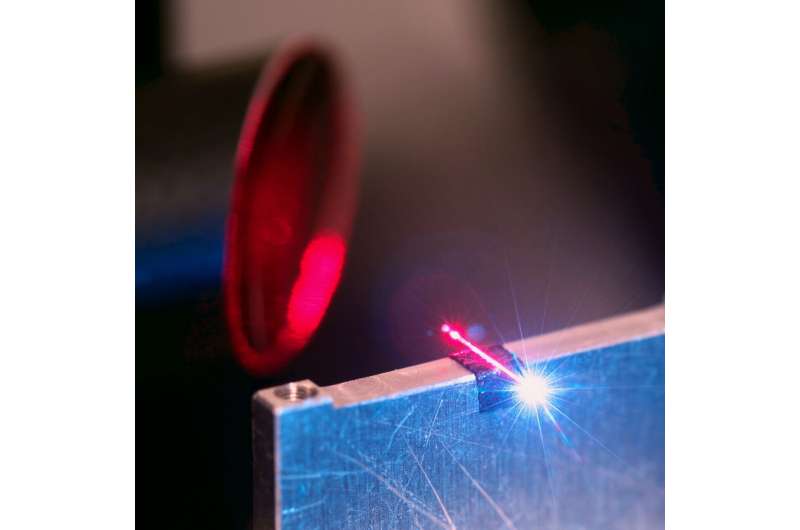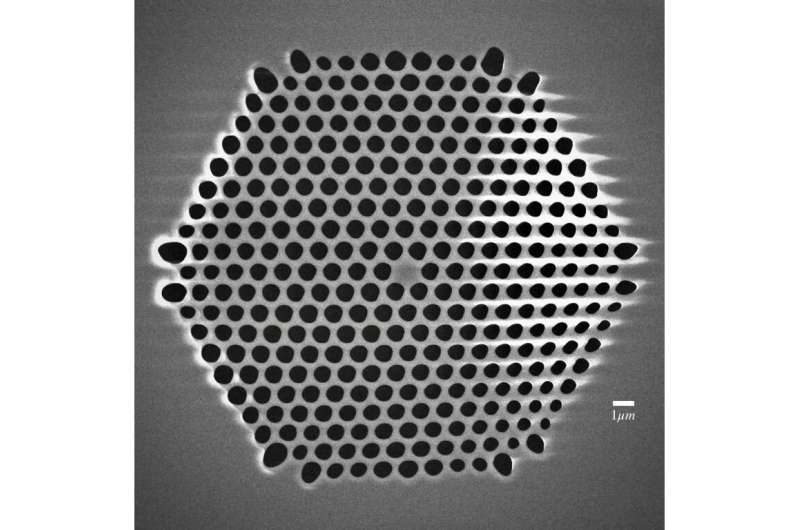The parabolic mirror in the background focuses dark-red light into the fibre that shines bright-blue on the other end. A tiny bit of the bright light is Hawking radiation, which the researchers extracted and measured. Credit: Drori et al.
Researchers at Weizmann Institute of Science and Cinvestav recently carried out a study testing the theory of Hawking radiation on laboratory analogues of black holes. In their experiments, they used light pulses in nonlinear fiber optics to establish artificial event horizons.
Back in 1974, renowned physicist Stephen Hawking amazed the physics world with his theory of Hawking radiation, which suggested that rather than being black, black holes should glow slightly due to quantum effects near the black hole's event horizon. According to Hawking's theory, the strong gravitational field around a black hole can affect the production of matching pairs of particles and anti-particles.
Should these particles be created just outside the event horizon, the positive member of this pair of particles could escape, resulting in an observed thermal radiation emitting from the black hole. This radiation, which was later termed Hawking radiation, would hence consist of photons, neutrinos and other subatomic particles. The theory of Hawking radiation was among the first to combine concepts from quantum mechanics with Albert Einstein's theory of General Relativity.
"I learned General Relativity in 1997 by lecturing a course, not by taking a course," Ulf Leonhardt, one of the researchers who carried out the recent study, told Phys.org. "This was a rather stressful experience where I was just a few weeks ahead of the students, but I really got to know General Relativity and fell in love with it. Fittingly, this also happened in Ulm, Einstein's birthplace. Since then, I have been looking for connections between my field of research, quantum optics and General Relativity. My main goal is to demystify General Relativity. If, as I and others have shown, ordinary optical materials like glass act like curved spaces, then the curved space-time of General Relativity becomes something tangible, without losing its charm."
In collaboration with his first Ph.D. student Paul Piwnicki, Leonhardt put together some initial ideas of how to create optical black holes, which were published in 1999 and 2000. In 2004, he finally achieved a method that actually worked, which is the one used in his recent study.
"Imagine, like in Einstein's gedanken experiments, light chasing after another pulse of light," Leonhardt explained. "Suppose that all the light travels inside an optical fiber. In the fiber glass, the pulse changes the speed of the light chasing it a little, such that the light cannot overtake the pulse. It experiences a white-hole horizon; a place it cannot enter. The front of the pulse acts like the exact opposite: a black-hole horizon, a place the light cannot leave. This is the idea in a nutshell."
Leonhardt and his colleagues published and demonstrated this idea in 2008. Subsequently, they tried to use it to demonstrate Hawking radiation.
Hawking radiation has never been directly observed in space, as this is not currently feasible. However, it can be demonstrated in laboratory environments, for instance, using Bose-Einstein condensates, water waves, polaritons or light. In the past, several researchers tried to test Hawking radiation in the lab using these techniques, yet most of their studies were, in fact, problematic and have thus been disputed.
This image shows an electron-microscope picture of the interior of one of the researchers’ fibres. The fibres are sophisticated photopic-crystal fibres. They are as thin as a human hair and inside they carry hole structures that guide the light in the centre. Credit: Drori et al.
For instance, some past findings obtained with intense light pulses in optical media turned out to be inconsistent with theory. Rather than observing Hawking radiation made by horizons, as the authors themselves found out later, they had, in fact, observed horizon-less radiation created by their light pulses, as they exceeded the phase velocity of light for other frequencies. Other studies attempting to observe Hawking radiation on water waves and in Bose-Einstein condensates also turned out to be problematic.
Discussing the outcomes of these studies with Physics World, Leonhardt wrote, "I greatly admire the heroism of the people doing them, and their technical skills and expertise, but this is a difficult subject." He also wrote: "Horizons are perfect traps; it is easy to get trapped behind them without noticing, and this applies to horizon research, as well. We learn and become experts according to the classic definition: An expert is someone who has made all possible mistakes (and learned from them)."
As proven by previous efforts, observing Hawking radiation in the lab is a highly challenging task. The study carried out by Leonhardt and his colleagues could be the first valid demonstration of Hawking radiation in optics.
"Black holes are surrounded by their event horizons," Leonhardt explained. "The horizon marks the border where light can no longer escape. Hawking predicted that at the horizon light quanta—photons—are created. One photon appears outside the horizon and is able to get away, while its partner appears on the inside and falls into the black hole. According to quantum mechanics, particles are associated with waves. The photon on the outside belongs to a wave that oscillates with positive frequency, the wave of its partner on the inside oscillates with a negative frequency."
In their study, Leonhardt and his colleagues made light out of positive and negative frequencies. Their positive-frequency light was infrared, while the negative-frequency one was ultraviolet. The researchers detected both of them and then compared them with Hawking's theory.
The tiny bit of ultraviolet light that they managed to detect using sensitive equipment is the first clear sign of stimulated Hawking radiation in optics. This radiation is referred to as 'stimulated' because it is stimulated by the probe light that the researchers sent in to chase the pulses.
"Our most important finding, perhaps, is that black holes are not something out of the ordinary, but that they closely resemble what light pulses do to ordinary light in fibers," Leonhardt said. "Demonstrating subtle quantum phenomena like Hawking radiation is not easy. It takes extremely short pulses, extraordinary fibers, sensitive equipment and, last but not least, the hard work of dedicated students. But even Hawking radiation is something one can actually understand."
The study carried out by Leonhardt and his colleagues is an important contribution to the physics field, as it provides the first laboratory demonstration of Hawking radiation in optics. The researchers also found the analogy to event horizons to be remarkably robust, despite pushing the optics to the extreme, which increased their confidence in the validity of their theories.
"We now need to improve our setup to get ready for the next big challenge: the observation of spontaneous Hawking radiation," Leonhardt said. "In this case, the radiation is not stimulated anymore, except by the inevitable fluctuations of the quantum vacuum. Our next goals are steps that improve the apparatus and test various aspects of stimulated Hawking radiation, before going all the way to spontaneous Hawking radiation."
More information: Silke Weinfurtner et al. Measurement of Stimulated Hawking Emission in an Analogue System, Physical Review Letters (2011). DOI: 10.1103/PhysRevLett.106.021302
F. Belgiorno et al. Hawking Radiation from Ultrashort Laser Pulse Filaments, Physical Review Letters (2010). DOI: 10.1103/PhysRevLett.105.203901
Ulf Leonhardt. Questioning the Recent Observation of Quantum Hawking Radiation, Annalen der Physik (2018). DOI: 10.1002/andp.201700114
Jonathan Drori et al. Observation of Stimulated Hawking Radiation in an Optical Analogue, Physical Review Letters (2019). DOI: 10.1103/PhysRevLett.122.010404
Journal information: Physical Review Letters , Physics World
© 2019 Science X Network
























